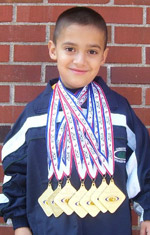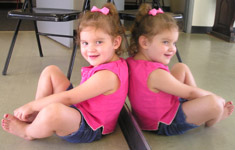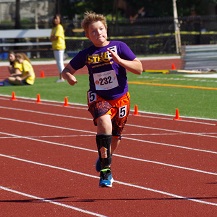
Parents share their thoughts on the benefits of sports
Though no one in our family is a professional athlete, our daughter (age 14, with left hemiplegia and epilepsy) is the 2001 National CP7 Champion in a number of disability track and field events. She also plays “regular” tennis at the tournament level, earning an official USTA ranking of 318 in the state of Florida against able-bodied 14 year old opponents. In addition, her father and I have both been involved in sports and athletics all of our lives as collegiate athletes, children’s coaches, fitness instructors, and recreational/amateur athletes in a number of sports.
The general consensus is that sports participation offers immense benefits to children with brain injury. Based on my own direct experience in sports and disability sports, as well as the many discussions on sports topics by parents participating in the children with cerebral palsy online support group it is quite clear that, at the very least, children with cerebral palsy benefit from sports participation to the same extent that non-disabled children benefit. However, I believe the potential benefits are even greater for children with brain injury as sports participation directly and positively supports the added developmental needs of these children.
 Sports can also be especially helpful for children with attention deficit and hyperactivity. Not only does sports participation give such children a positive way to channel off their extra energy, it helps them gain control. To play their sport, they must learn to focus, pay attention, concentrate, be patient, follow instructions, and manage their impulses. They must also learn to remember and apply rules, plays, and strategies, even when they are excited. Once such cognitive skills are acquired within the sports arena, there is strong carry over into other areas of their life.
Sports can also be especially helpful for children with attention deficit and hyperactivity. Not only does sports participation give such children a positive way to channel off their extra energy, it helps them gain control. To play their sport, they must learn to focus, pay attention, concentrate, be patient, follow instructions, and manage their impulses. They must also learn to remember and apply rules, plays, and strategies, even when they are excited. Once such cognitive skills are acquired within the sports arena, there is strong carry over into other areas of their life.
From a physical perspective, sports participation develops balance, coordination, agility, flexibility, and body awareness. It increases strength and endurance, builds muscles and bones, and stretches and strengthens connective tissue. It improves circulation and oxygenation, allowing for removal of toxins. It also increases sensation throughout the body. Sports participation helps the child develop spatial awareness, and a physical understanding of rhythm, timing, cadence, and distance.
 From a cognitive perspective, sports participation builds concentration, focus, and memory. It teaches self-control, persistence, patience and self-discipline. It promotes creative thinking and visualization, and helps the child develop a positive mental attitude, self-confidence, and self-respect. Learning to keep score teaches abstract math skills and builds short-term memory capabilities. Learning the various sports plays, maneuvers, and strategies builds memory and teaches split second decision-making and strategic thinking. From my personal experience with my daughter, I have found that the more her physical body developed, the more her cognitive abilities improved and learning disabilities diminished. As sports participation improves and/or increases the connections between the brain and the body, communications between her left-brain and right brain were also expanded and/or facilitated allowing her to “think” and conceptualize more easily. Time and time again, I observed that as she would reach each new levels of physical capability and functioning, her reading and math abilities always seemed to improve in tandem. As an added benefit, her desire to play sports motivated to accept medical treatments and therapies when they were needed, in the interest of improving her sports performance down the road.
From a cognitive perspective, sports participation builds concentration, focus, and memory. It teaches self-control, persistence, patience and self-discipline. It promotes creative thinking and visualization, and helps the child develop a positive mental attitude, self-confidence, and self-respect. Learning to keep score teaches abstract math skills and builds short-term memory capabilities. Learning the various sports plays, maneuvers, and strategies builds memory and teaches split second decision-making and strategic thinking. From my personal experience with my daughter, I have found that the more her physical body developed, the more her cognitive abilities improved and learning disabilities diminished. As sports participation improves and/or increases the connections between the brain and the body, communications between her left-brain and right brain were also expanded and/or facilitated allowing her to “think” and conceptualize more easily. Time and time again, I observed that as she would reach each new levels of physical capability and functioning, her reading and math abilities always seemed to improve in tandem. As an added benefit, her desire to play sports motivated to accept medical treatments and therapies when they were needed, in the interest of improving her sports performance down the road.
 From a social perspective, sports participation teaches social skills, teamwork, and sportsmanship. It teaches children how to be supportive, enjoy success, and accept disappointment. It also offers opportunity to meet others and develop friendships within a structured environment.
From a social perspective, sports participation teaches social skills, teamwork, and sportsmanship. It teaches children how to be supportive, enjoy success, and accept disappointment. It also offers opportunity to meet others and develop friendships within a structured environment.
Unfortunately, I believe the positives of sports participation tend to be greatly underestimated and often overlooked. This is partly due to what I believe is a general lack of disability sports knowledge. In the traditional medical model of treatment, the focus is solely on medical solutions to physical problems, rather then a focus on non-medical ways to achieve similar goals. This is not meant as a criticism. Specialized medical and therapy treatments are quite necessary in most instances for children with cerebral palsy.
In the early years, following diagnosis, parents are often guided by the medical model of treatment and may not even consider participation in sports as a possibility for their child. Parents may steer away from or delay sports activities that could prove very beneficial for their child as they grow and for a lifetime. Because early sports participation of any kind can be so helpful in laying a foundation for further development—by building strength and maintaining range of motion and flexibility so necessary for more normalized gait, posture, and positioning—it is important for the medical and educational communities to urge families to consider sports programs for any child who has a disability.
In all sports, parents should expect progress to be slower for children with cerebral palsy compared to typically developing children. Please be patient. If your child really and truly loves a sport, let her go for it, despite slow progress. Love of a sport will motivate your child to do her best and try to succeed. – Rene






